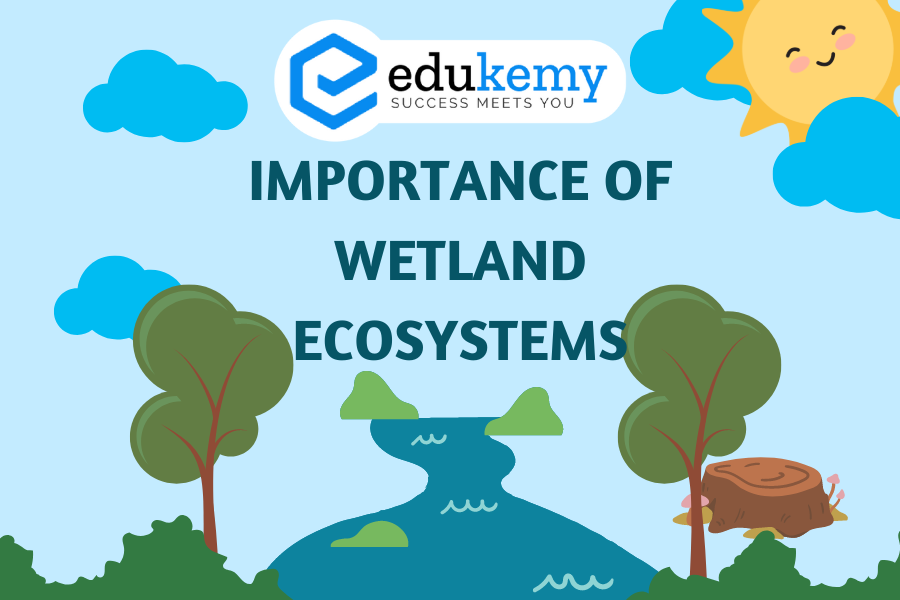- Wetland ecosystems represent transitional zones between terrestrial and aquatic ecosystems, forming an ecotone.
- As per the Ramsar Convention on Wetlands, wetlands are characterized as areas encompassing marshes, fens, and peatlands.
- These areas may be either temporary or permanent, arising through natural or artificial processes.
- Wetlands include environments with fresh, brackish, or saltwater, where the depth of marine water at low tide does not surpass six meters in height.
Contents
FUNCTIONS OF WETLANDS
Wetlands play a crucial role in sustaining ecosystems and providing a myriad of values and benefits. Here’s an in-depth look at the various functions they perform and the advantages they offer:
1. Source of Water:
Wetlands are a primary source of fresh water, with aquifer-stored groundwater constituting over 95 percent of all available freshwater. They aid in rainwater absorption, groundwater recharge, and serve domestic, irrigation, and drinking water needs.
2. Flood and Storm Buffer Zone:
Acting as natural buffers, wetlands alleviate droughts and mitigate floods. They function as sponges, absorbing rainfall and snowmelt, allowing water to gently percolate into the soil. Coastal wetlands, including mangroves and coral reefs, act as physical barriers against storm surges and tidal waves.
3. Wetland Products:
Coastal wetlands contribute over two-thirds of the global fish supply, a crucial source of animal protein. Well-managed wetlands supply a diverse range of plants, animals, and minerals. They play a vital role in rice production, and many, like the Sundarbans, produce honey and other valuable products.
4. Water Purifier:
Wetlands aid in water purification by trapping contaminants in sediments and plants. They significantly lower pollutant levels, such as phosphorus and nitrogen from agricultural runoff. Certain wetland plants can eliminate harmful compounds from pesticides, industrial discharge, and mining.
5. Wetland for Research and Education:
Wetlands serve as excellent sites for learning about aquatic ecosystems and conducting research. Their habitat diversity, ecosystem complexity, and cultural ties make them ideal for multi-disciplinary studies. Examples include the Bhitarkanika Mangroves in Odisha and Bhoj Wetlands in Madhya Pradesh.
6. Recreation Property of Wetlands:
Wetlands offer relaxation and tourism opportunities due to their natural beauty and diverse plant and animal life. Locations like Mandawali village in NCT Delhi serve as recreational sites.
7. Combat Climate Change:
Wetlands, including mangroves and salt marshes, operate as carbon sinks, preventing greenhouse gas emissions. They play a crucial role in moderating and adapting to climate change. Wetland conservation is vital for protecting aquatic habitats threatened by climate change.
8. Habitats of Migratory Birds:
Migrating birds use wetlands as feeding, resting, and nesting stopovers. Indian wetlands, like Bakhira Wildlife Sanctuary and Ashtamudi Wetlands, are essential components of the Central Asian and East Australasian Flyways.
9. Biodiversity Hotspots:
Several wetlands serve as habitats for a variety of endemic and near-endangered species. Examples include Kaziranga National Park for the Great Indian Rhinoceros and Keibul Lamjao for the Brow-antlered Deer. Chilika Lake is home to endangered Irrawaddy Dolphins, and Koonthankulam Bird Sanctuary in Tamil Nadu.
SIGNIFICANCE OF WETLANDS
- Wetlands play a crucial role in the hydrological cycle, boasting abundant biodiversity that enhances various ecosystem services.
- These areas contribute valuable services, including waste assimilation, flood mitigation, erosion control, groundwater recharge, microclimate regulation, and water purification.
- Additionally, wetlands hold cultural significance by fostering meaningful recreation and supporting socio-cultural activities.
FAQs – Wetland Ecosystems
1-What defines wetland ecosystems according to the Ramsar Convention?
A: Wetland ecosystems are transitional zones between terrestrial and aquatic ecosystems, encompassing areas such as marshes, fens, and peatlands. They can be temporary or permanent, formed naturally or artificially, and include environments with fresh, brackish, or saltwater. The depth of marine water at low tide within wetlands does not exceed six meters.
2-What functions do wetlands perform in ecosystems?
A: Wetlands play a crucial role in sustaining ecosystems, offering values and benefits such as being a primary source of fresh water, flood mitigation, habitat for diverse species, and supporting various cultural and recreational activities.
3-How do wetlands serve as a source of water?
A: Wetlands contribute significantly to our primary source of fresh water, with groundwater stored in aquifers constituting over 95 percent of available freshwater. They aid in rainwater absorption, groundwater recharge, and fulfill various water needs, including domestic, irrigation, and drinking water.
4-In what ways do wetlands act as flood and storm buffer zones?
A: Wetlands function as natural buffers, alleviating droughts and mitigating floods. They absorb rainfall and snowmelt, allowing water to percolate gently into the soil. Coastal wetlands, like mangroves and coral reefs, act as physical barriers against storm surges and tidal waves.
5-What products and benefits do wetlands provide?
A: Coastal wetlands contribute significantly to the global fish supply, offering over two-thirds of fish, a crucial source of animal protein. Well-managed wetlands supply diverse resources, including plants, animals, and minerals, and play a vital role in rice production.
In case you still have your doubts, contact us on 9811333901.
For UPSC Prelims Resources, Click here
For Daily Updates and Study Material:
Join our Telegram Channel – Edukemy for IAS
- 1. Learn through Videos – here
- 2. Be Exam Ready by Practicing Daily MCQs – here
- 3. Daily Newsletter – Get all your Current Affairs Covered – here
- 4. Mains Answer Writing Practice – here

